Deck 6: Additional Integration Topics
سؤال
سؤال
سؤال
سؤال
سؤال
سؤال
سؤال
سؤال
سؤال
سؤال
سؤال
سؤال
سؤال
سؤال
سؤال
سؤال
سؤال
سؤال
سؤال
سؤال
سؤال
سؤال
سؤال
سؤال
سؤال
سؤال
سؤال
سؤال
سؤال
سؤال
سؤال
سؤال
سؤال
سؤال
سؤال
سؤال
سؤال
سؤال
سؤال
سؤال
سؤال
سؤال
سؤال
سؤال
سؤال
سؤال
سؤال
سؤال
سؤال
سؤال
سؤال
سؤال
سؤال
سؤال
سؤال
سؤال
سؤال
سؤال
سؤال
سؤال
سؤال
سؤال
سؤال
سؤال
سؤال
سؤال
سؤال
سؤال
سؤال
سؤال
سؤال
سؤال
سؤال
سؤال
سؤال
سؤال
سؤال
سؤال
سؤال
سؤال

فتح الحزمة
قم بالتسجيل لفتح البطاقات في هذه المجموعة!
Unlock Deck
Unlock Deck
1/82
العب
ملء الشاشة (f)
Deck 6: Additional Integration Topics
1
Solve the problem.
The Lorenz curve for the income distribution in a certain country is given by I) Find the Gini index of income concentration. II) Use the answer found in I) to determine if the income of this country is more equally distributed, less equally
I) Find the Gini index of income concentration. II) Use the answer found in I) to determine if the income of this country is more equally distributed, less equally
Distributed, or distributed the same as a second country having an index of income concentration of 0.2.
A) I) 0.33
B) I) 0.25 II) less equally distributed II) less equally distributed
C) I) 0.25
D) I) 0.33 II) more equally distributed II) more equally distributed
The Lorenz curve for the income distribution in a certain country is given by
 I) Find the Gini index of income concentration. II) Use the answer found in I) to determine if the income of this country is more equally distributed, less equally
I) Find the Gini index of income concentration. II) Use the answer found in I) to determine if the income of this country is more equally distributed, less equallyDistributed, or distributed the same as a second country having an index of income concentration of 0.2.
A) I) 0.33
B) I) 0.25 II) less equally distributed II) less equally distributed
C) I) 0.25
D) I) 0.33 II) more equally distributed II) more equally distributed
I) 0.25 II) less equally distributed II) less equally distributed
2
Provide an appropriate response.
Find the area bounded by and y = x + 1.
and y = x + 1.
A)
B)
C) 54
D)
Find the area bounded by
 and y = x + 1.
and y = x + 1.A)

B)

C) 54
D)


3
Solve the problem.
The Lorenz curve for the income distribution in a small country is given by the function Find the Gini index of income concentration. Round the answer to three decimal places.
Find the Gini index of income concentration. Round the answer to three decimal places.
A) 0.474
B) 0.143
C) 0.263
D) 0.35714
The Lorenz curve for the income distribution in a small country is given by the function
 Find the Gini index of income concentration. Round the answer to three decimal places.
Find the Gini index of income concentration. Round the answer to three decimal places.A) 0.474
B) 0.143
C) 0.263
D) 0.35714
0.474
4
Set up a definite integral that represents the shaded area.
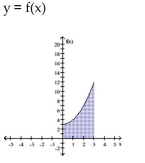
A)
B)
C)
D)

A)

B)

C)

D)


فتح الحزمة
افتح القفل للوصول البطاقات البالغ عددها 82 في هذه المجموعة.
فتح الحزمة
k this deck
5
Solve the problem.

A) 145.69
B) 6.70
C) 400.71
D) 27.29

A) 145.69
B) 6.70
C) 400.71
D) 27.29

فتح الحزمة
افتح القفل للوصول البطاقات البالغ عددها 82 في هذه المجموعة.
فتح الحزمة
k this deck
6
Set up a definite integral that represents the shaded area.
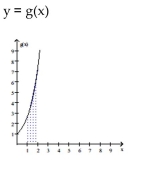
A)
B)
C)
D)

A)

B)

C)

D)


فتح الحزمة
افتح القفل للوصول البطاقات البالغ عددها 82 في هذه المجموعة.
فتح الحزمة
k this deck
7
Provide an appropriate response.
Find the area lying above the x-axis and under the parabola . (Round answers to three decimal places.)
. (Round answers to three decimal places.)
A) 32
B) 10.667
C) - 10.667
D) 11
Find the area lying above the x-axis and under the parabola
 . (Round answers to three decimal places.)
. (Round answers to three decimal places.)A) 32
B) 10.667
C) - 10.667
D) 11

فتح الحزمة
افتح القفل للوصول البطاقات البالغ عددها 82 في هذه المجموعة.
فتح الحزمة
k this deck
8
Provide an appropriate response.
Find the area bounded by y = 0 for 0 ≤ x ≤ 1.
y = 0 for 0 ≤ x ≤ 1.
A) 1
B) 2
C) 3
D) 6
Find the area bounded by
 y = 0 for 0 ≤ x ≤ 1.
y = 0 for 0 ≤ x ≤ 1.A) 1
B) 2
C) 3
D) 6

فتح الحزمة
افتح القفل للوصول البطاقات البالغ عددها 82 في هذه المجموعة.
فتح الحزمة
k this deck
9
Provide an appropriate response.
Find the area between the graph of and the x-axis over the interval
and the x-axis over the interval  (Round answer to two decimal places, if necessary.)
(Round answer to two decimal places, if necessary.)
A) 12.13
B) 3.22
C) 20.13
D) 8.97
Find the area between the graph of
 and the x-axis over the interval
and the x-axis over the interval  (Round answer to two decimal places, if necessary.)
(Round answer to two decimal places, if necessary.)A) 12.13
B) 3.22
C) 20.13
D) 8.97

فتح الحزمة
افتح القفل للوصول البطاقات البالغ عددها 82 في هذه المجموعة.
فتح الحزمة
k this deck
10
Solve the problem.
The Lorenz curve for the income distribution in a certain country is given by the function . Find the
. Find the
Gini index of income concentration. Round the answer to three decimal places and interpret the results.
The Lorenz curve for the income distribution in a certain country is given by the function
 . Find the
. Find theGini index of income concentration. Round the answer to three decimal places and interpret the results.

فتح الحزمة
افتح القفل للوصول البطاقات البالغ عددها 82 في هذه المجموعة.
فتح الحزمة
k this deck
11
Provide an appropriate response.
Find the area between the graph of![<strong>Provide an appropriate response. Find the area between the graph of and the x-axis over the interval [-5, 5]. (Round answer to two decimal places.)</strong> A) 333.33 B) 33.33 C) 666.67 D) 66.67](https://d2lvgg3v3hfg70.cloudfront.net/TB8593/11ebb6d7_489c_2a79_b437_414c8483131f_TB8593_11.jpg) and the x-axis over the interval [-5, 5]. (Round answer to two decimal places.)
and the x-axis over the interval [-5, 5]. (Round answer to two decimal places.)
A) 333.33
B) 33.33
C) 666.67
D) 66.67
Find the area between the graph of
![<strong>Provide an appropriate response. Find the area between the graph of and the x-axis over the interval [-5, 5]. (Round answer to two decimal places.)</strong> A) 333.33 B) 33.33 C) 666.67 D) 66.67](https://d2lvgg3v3hfg70.cloudfront.net/TB8593/11ebb6d7_489c_2a79_b437_414c8483131f_TB8593_11.jpg) and the x-axis over the interval [-5, 5]. (Round answer to two decimal places.)
and the x-axis over the interval [-5, 5]. (Round answer to two decimal places.)A) 333.33
B) 33.33
C) 666.67
D) 66.67

فتح الحزمة
افتح القفل للوصول البطاقات البالغ عددها 82 في هذه المجموعة.
فتح الحزمة
k this deck
12
Provide an appropriate response.
Find the area between the graph of f(x) = 50 +![<strong>Provide an appropriate response. Find the area between the graph of f(x) = 50 + and the x-axis over the interval [-2, 4].</strong> A) 372 B) 269 C) 92 D) -92](https://d2lvgg3v3hfg70.cloudfront.net/TB8593/11ebb6d7_489c_0363_b437_17665e24fb7a_TB8593_11.jpg) and the x-axis over the interval [-2, 4].
and the x-axis over the interval [-2, 4].
A) 372
B) 269
C) 92
D) -92
Find the area between the graph of f(x) = 50 +
![<strong>Provide an appropriate response. Find the area between the graph of f(x) = 50 + and the x-axis over the interval [-2, 4].</strong> A) 372 B) 269 C) 92 D) -92](https://d2lvgg3v3hfg70.cloudfront.net/TB8593/11ebb6d7_489c_0363_b437_17665e24fb7a_TB8593_11.jpg) and the x-axis over the interval [-2, 4].
and the x-axis over the interval [-2, 4].A) 372
B) 269
C) 92
D) -92

فتح الحزمة
افتح القفل للوصول البطاقات البالغ عددها 82 في هذه المجموعة.
فتح الحزمة
k this deck
13
Provide an appropriate response.
Find the area bounded by and g(x) = 2x + 7. (Round answer to two decimal places.)
and g(x) = 2x + 7. (Round answer to two decimal places.)
A) 32.65
B) 20.83
C) 55.83
D) 16.13
Find the area bounded by
 and g(x) = 2x + 7. (Round answer to two decimal places.)
and g(x) = 2x + 7. (Round answer to two decimal places.)A) 32.65
B) 20.83
C) 55.83
D) 16.13

فتح الحزمة
افتح القفل للوصول البطاقات البالغ عددها 82 في هذه المجموعة.
فتح الحزمة
k this deck
14
Provide an appropriate response.
Find the area between the graph of and the x-axis over the interval
and the x-axis over the interval  (Round answer to two decimal places.)
(Round answer to two decimal places.)
A) 32.33
B) 5.33
C) 27
D) 21.67
Find the area between the graph of
 and the x-axis over the interval
and the x-axis over the interval  (Round answer to two decimal places.)
(Round answer to two decimal places.)A) 32.33
B) 5.33
C) 27
D) 21.67

فتح الحزمة
افتح القفل للوصول البطاقات البالغ عددها 82 في هذه المجموعة.
فتح الحزمة
k this deck
15
Solve the problem.

A) 0.99
B) 0.36
C) 147.41
D) 145.69

A) 0.99
B) 0.36
C) 147.41
D) 145.69

فتح الحزمة
افتح القفل للوصول البطاقات البالغ عددها 82 في هذه المجموعة.
فتح الحزمة
k this deck
16
Solve the problem.
The Lorenz curve for the income distribution in a small country is given by the function Find the Gini index of income concentration. Round the answer to three decimal places.
Find the Gini index of income concentration. Round the answer to three decimal places.
A) -0.584
B) 0.684
C) 0.584
D) 0.292
The Lorenz curve for the income distribution in a small country is given by the function
 Find the Gini index of income concentration. Round the answer to three decimal places.
Find the Gini index of income concentration. Round the answer to three decimal places.A) -0.584
B) 0.684
C) 0.584
D) 0.292

فتح الحزمة
افتح القفل للوصول البطاقات البالغ عددها 82 في هذه المجموعة.
فتح الحزمة
k this deck
17
Provide an appropriate response.
Find the area bounded by the parabolas (Round answer to three decimal places.)
(Round answer to three decimal places.)
A) - 21.333
B) 21.333
C) 21.667
D) 22
Find the area bounded by the parabolas
 (Round answer to three decimal places.)
(Round answer to three decimal places.)A) - 21.333
B) 21.333
C) 21.667
D) 22

فتح الحزمة
افتح القفل للوصول البطاقات البالغ عددها 82 في هذه المجموعة.
فتح الحزمة
k this deck
18
Provide an appropriate response.
Find the area between the graph of![<strong>Provide an appropriate response. Find the area between the graph of and the x-axis over the interval [1, 3]. (Round answer to two decimal places.)</strong> A) 8.67 B) 10 C) 8 D) - 8.67](https://d2lvgg3v3hfg70.cloudfront.net/TB8593/11ebb6d7_489c_518f_b437_c971d131a40e_TB8593_11.jpg) and the x-axis over the interval [1, 3]. (Round answer to two decimal places.)
and the x-axis over the interval [1, 3]. (Round answer to two decimal places.)
A) 8.67
B) 10
C) 8
D) - 8.67
Find the area between the graph of
![<strong>Provide an appropriate response. Find the area between the graph of and the x-axis over the interval [1, 3]. (Round answer to two decimal places.)</strong> A) 8.67 B) 10 C) 8 D) - 8.67](https://d2lvgg3v3hfg70.cloudfront.net/TB8593/11ebb6d7_489c_518f_b437_c971d131a40e_TB8593_11.jpg) and the x-axis over the interval [1, 3]. (Round answer to two decimal places.)
and the x-axis over the interval [1, 3]. (Round answer to two decimal places.)A) 8.67
B) 10
C) 8
D) - 8.67

فتح الحزمة
افتح القفل للوصول البطاقات البالغ عددها 82 في هذه المجموعة.
فتح الحزمة
k this deck
19
Provide an appropriate response.
Find the area (to three decimal places) bounded by and
and 
A) 7.676
B) 7.0
C) 7.555
D) 7.333
Find the area (to three decimal places) bounded by
 and
and 
A) 7.676
B) 7.0
C) 7.555
D) 7.333

فتح الحزمة
افتح القفل للوصول البطاقات البالغ عددها 82 في هذه المجموعة.
فتح الحزمة
k this deck
20
Set up a definite integral that represents the shaded area.
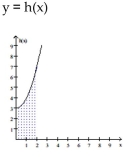
A)
B) x
x
C)
D)

A)

B)
 x
xC)

D)


فتح الحزمة
افتح القفل للوصول البطاقات البالغ عددها 82 في هذه المجموعة.
فتح الحزمة
k this deck
21
Solve the problem.
The length of telephone calls (in minutes) in a public telephone booth has the probability density function: Determine the probability that a call selected at random will last longer than seven minutes. (Round answer to two decimal places.)
Determine the probability that a call selected at random will last longer than seven minutes. (Round answer to two decimal places.)
A) 0.42
B) 0.31
C) 0.39
D) 0.54
The length of telephone calls (in minutes) in a public telephone booth has the probability density function:
 Determine the probability that a call selected at random will last longer than seven minutes. (Round answer to two decimal places.)
Determine the probability that a call selected at random will last longer than seven minutes. (Round answer to two decimal places.)A) 0.42
B) 0.31
C) 0.39
D) 0.54

فتح الحزمة
افتح القفل للوصول البطاقات البالغ عددها 82 في هذه المجموعة.
فتح الحزمة
k this deck
22
Find the producer's surplus for the following supply function at the given point.
Find the equilibrium price if the price-demand equation is and the price-supply equation
and the price-supply equation 
A) $13.00
B) $7.00
C) $60.00
D) $20.00
Find the equilibrium price if the price-demand equation is
 and the price-supply equation
and the price-supply equation 
A) $13.00
B) $7.00
C) $60.00
D) $20.00

فتح الحزمة
افتح القفل للوصول البطاقات البالغ عددها 82 في هذه المجموعة.
فتح الحزمة
k this deck
23
Solve the problem.
The length of telephone calls (in minutes) in a public telephone booth has the probability density function: Determine the probability that a call selected at random will last between 2 and 6 minutes. (Round answer to two decimal places.)
Determine the probability that a call selected at random will last between 2 and 6 minutes. (Round answer to two decimal places.)
A) 0.95
B) 0.65
C) 0.70
D) 0.35
The length of telephone calls (in minutes) in a public telephone booth has the probability density function:
 Determine the probability that a call selected at random will last between 2 and 6 minutes. (Round answer to two decimal places.)
Determine the probability that a call selected at random will last between 2 and 6 minutes. (Round answer to two decimal places.)A) 0.95
B) 0.65
C) 0.70
D) 0.35

فتح الحزمة
افتح القفل للوصول البطاقات البالغ عددها 82 في هذه المجموعة.
فتح الحزمة
k this deck
24
Find the producer's surplus for the following supply function at the given point.
Find the equilibrium quantity if the price-demand equation is , and the price-supply equation is
, and the price-supply equation is 
A) -600, 200
B) 200
C) -600
D) 13
Find the equilibrium quantity if the price-demand equation is
 , and the price-supply equation is
, and the price-supply equation is 
A) -600, 200
B) 200
C) -600
D) 13

فتح الحزمة
افتح القفل للوصول البطاقات البالغ عددها 82 في هذه المجموعة.
فتح الحزمة
k this deck
25
Solve the problem.
The rate of flow of income from a continuous income stream is given by Find the future value of this income stream at 8% compounded continuously for six years. (Round answer to the nearest dollar.)
Find the future value of this income stream at 8% compounded continuously for six years. (Round answer to the nearest dollar.)
A) $2743
B) $2706
C) $14,286
D) $4375
The rate of flow of income from a continuous income stream is given by
 Find the future value of this income stream at 8% compounded continuously for six years. (Round answer to the nearest dollar.)
Find the future value of this income stream at 8% compounded continuously for six years. (Round answer to the nearest dollar.)A) $2743
B) $2706
C) $14,286
D) $4375

فتح الحزمة
افتح القفل للوصول البطاقات البالغ عددها 82 في هذه المجموعة.
فتح الحزمة
k this deck
26
Solve the problem.
Find the total income produced by a continuous income stream in the first nine years if the rate of flow is f(t) = 3300.
A) $27,000
B) $9900
C) $18,000
D) $29,700
Find the total income produced by a continuous income stream in the first nine years if the rate of flow is f(t) = 3300.
A) $27,000
B) $9900
C) $18,000
D) $29,700

فتح الحزمة
افتح القفل للوصول البطاقات البالغ عددها 82 في هذه المجموعة.
فتح الحزمة
k this deck
27
Find the consumer's surplus for the following demand function at the given point.

A) $3.25
B) $7.28
C) $4.50
D) $4.33

A) $3.25
B) $7.28
C) $4.50
D) $4.33

فتح الحزمة
افتح القفل للوصول البطاقات البالغ عددها 82 في هذه المجموعة.
فتح الحزمة
k this deck
28
Solve the problem.
Find the total income produced by a continuous income stream in the first nine years if the rate of flow is f(t) =5000.
A) $4500
B) $22.500
C) $90,000
D) $45,000
Find the total income produced by a continuous income stream in the first nine years if the rate of flow is f(t) =5000.
A) $4500
B) $22.500
C) $90,000
D) $45,000

فتح الحزمة
افتح القفل للوصول البطاقات البالغ عددها 82 في هذه المجموعة.
فتح الحزمة
k this deck
29
Find the producer's surplus for the following supply function at the given point.
Find the producers' surplus at a price level of for the price-supply equation
for the price-supply equation 
Find the producers' surplus at a price level of
 for the price-supply equation
for the price-supply equation 

فتح الحزمة
افتح القفل للوصول البطاقات البالغ عددها 82 في هذه المجموعة.
فتح الحزمة
k this deck
30
Solve the problem.
Find the future value at 9% interest compounded continuously for five years for the continuous income stream with rate of flow f(t) = 750. (Round answer to the nearest dollar.)
A) $750
B) $4736
C) $474
D) $47,359
Find the future value at 9% interest compounded continuously for five years for the continuous income stream with rate of flow f(t) = 750. (Round answer to the nearest dollar.)
A) $750
B) $4736
C) $474
D) $47,359

فتح الحزمة
افتح القفل للوصول البطاقات البالغ عددها 82 في هذه المجموعة.
فتح الحزمة
k this deck
31
Solve the problem.

A) 70.04
B) 23.19
C) 77.89
D) 53.64

A) 70.04
B) 23.19
C) 77.89
D) 53.64

فتح الحزمة
افتح القفل للوصول البطاقات البالغ عددها 82 في هذه المجموعة.
فتح الحزمة
k this deck
32
Solve the problem.
The rate of flow of a continuous income stream (in thousands of dollars per day) is given by Find the total income produced during the first ten days of operation.
Find the total income produced during the first ten days of operation.
A) $58,874.14
B) $2843.18
C) $239.79
D) $2397.90
The rate of flow of a continuous income stream (in thousands of dollars per day) is given by
 Find the total income produced during the first ten days of operation.
Find the total income produced during the first ten days of operation.A) $58,874.14
B) $2843.18
C) $239.79
D) $2397.90

فتح الحزمة
افتح القفل للوصول البطاقات البالغ عددها 82 في هذه المجموعة.
فتح الحزمة
k this deck
33
Solve the problem.
Find the interest earned at 5% compounded continuously for two years by a continuous income stream with rate flow of f(t) = 1250. (Round answer to the nearest dollar.)
A) $22,621
B) $2629
C) $129
D) $2379
Find the interest earned at 5% compounded continuously for two years by a continuous income stream with rate flow of f(t) = 1250. (Round answer to the nearest dollar.)
A) $22,621
B) $2629
C) $129
D) $2379

فتح الحزمة
افتح القفل للوصول البطاقات البالغ عددها 82 في هذه المجموعة.
فتح الحزمة
k this deck
34
Find the consumer's surplus for the following demand function at the given point.
Find the consumers' surplus at a price level of for the price-demand equation
for the price-demand equation 
A) $4050
B) $720
C) $405
D) $29,250
Find the consumers' surplus at a price level of
 for the price-demand equation
for the price-demand equation 
A) $4050
B) $720
C) $405
D) $29,250

فتح الحزمة
افتح القفل للوصول البطاقات البالغ عددها 82 في هذه المجموعة.
فتح الحزمة
k this deck
35
Solve the problem.
Find the future value at 8% interest compounded continuously for five years for the continuous income stream with rate of flow f(t) = 560. (Round answer to the nearest dollar.)
A) $3443
B) $835
C) $2308
D) $2750
Find the future value at 8% interest compounded continuously for five years for the continuous income stream with rate of flow f(t) = 560. (Round answer to the nearest dollar.)
A) $3443
B) $835
C) $2308
D) $2750

فتح الحزمة
افتح القفل للوصول البطاقات البالغ عددها 82 في هذه المجموعة.
فتح الحزمة
k this deck
36
Find the equilibrium point.

A)
B)
C)
D)

A)

B)

C)

D)


فتح الحزمة
افتح القفل للوصول البطاقات البالغ عددها 82 في هذه المجموعة.
فتح الحزمة
k this deck
37
Solve the problem.
The life expectancy (in years) of a certain type of computer chip is a continuous random variable with probability density function: Find the probability that a randomly selected chip will last from three to seven years. (Round answer to two decimal
Find the probability that a randomly selected chip will last from three to seven years. (Round answer to two decimal
Places.)
A) 0.33
B) 0.21
C) 0.36
D) 0.57
The life expectancy (in years) of a certain type of computer chip is a continuous random variable with probability density function:
 Find the probability that a randomly selected chip will last from three to seven years. (Round answer to two decimal
Find the probability that a randomly selected chip will last from three to seven years. (Round answer to two decimalPlaces.)
A) 0.33
B) 0.21
C) 0.36
D) 0.57

فتح الحزمة
افتح القفل للوصول البطاقات البالغ عددها 82 في هذه المجموعة.
فتح الحزمة
k this deck
38
Solve the problem.
The rate of flow of a continuous income stream (in thousands of dollars per day) is given by Find the total income produced during the first thirty days of operation.
Find the total income produced during the first thirty days of operation.
A) $343.40
B) $34.34
C) $3433.99
D) $34,339.87
The rate of flow of a continuous income stream (in thousands of dollars per day) is given by
 Find the total income produced during the first thirty days of operation.
Find the total income produced during the first thirty days of operation.A) $343.40
B) $34.34
C) $3433.99
D) $34,339.87

فتح الحزمة
افتح القفل للوصول البطاقات البالغ عددها 82 في هذه المجموعة.
فتح الحزمة
k this deck
39
Find the producer's surplus for the following supply function at the given point.

A) $2
B) -$0.67
C) -$2
D) $0.67

A) $2
B) -$0.67
C) -$2
D) $0.67

فتح الحزمة
افتح القفل للوصول البطاقات البالغ عددها 82 في هذه المجموعة.
فتح الحزمة
k this deck
40
Solve the problem.
Find the total income produced by a continuous income stream in the first four years if the rate of flow is f(t) = 500e0.03t. (Round answer to the nearest dollar.)
A) $2125
B) $18,792
C) $564
D) $2486
Find the total income produced by a continuous income stream in the first four years if the rate of flow is f(t) = 500e0.03t. (Round answer to the nearest dollar.)
A) $2125
B) $18,792
C) $564
D) $2486

فتح الحزمة
افتح القفل للوصول البطاقات البالغ عددها 82 في هذه المجموعة.
فتح الحزمة
k this deck
41
Find the producer's surplus for the following supply function at the given point.
Find the equilibrium price and quantity,producers' surplus for
A)
B)
C)
D)
Find the equilibrium price and quantity,producers' surplus for

A)

B)

C)

D)


فتح الحزمة
افتح القفل للوصول البطاقات البالغ عددها 82 في هذه المجموعة.
فتح الحزمة
k this deck
42
Evaluate using integration by parts.

A)
B)
C)
D)

A)

B)

C)

D)


فتح الحزمة
افتح القفل للوصول البطاقات البالغ عددها 82 في هذه المجموعة.
فتح الحزمة
k this deck
43
Evaluate using integration by parts.

A)
B)
C)
D)

A)

B)

C)

D)


فتح الحزمة
افتح القفل للوصول البطاقات البالغ عددها 82 في هذه المجموعة.
فتح الحزمة
k this deck
44
Evaluate using integration by parts.

A)
B)
C)
D)

A)

B)

C)

D)


فتح الحزمة
افتح القفل للوصول البطاقات البالغ عددها 82 في هذه المجموعة.
فتح الحزمة
k this deck
45
Evaluate using integration by parts.

A)
B)
C)
D)

A)

B)

C)

D)


فتح الحزمة
افتح القفل للوصول البطاقات البالغ عددها 82 في هذه المجموعة.
فتح الحزمة
k this deck
46
Find the producer's surplus for the following supply function at the given point.
Find the consumers' surplus and producers' surplus for
A)
B)
C)
D)
Find the consumers' surplus and producers' surplus for

A)

B)

C)

D)


فتح الحزمة
افتح القفل للوصول البطاقات البالغ عددها 82 في هذه المجموعة.
فتح الحزمة
k this deck
47
Evaluate using integration by parts.

A) 2.8588
B) 5.0213
C) 1.4597
D) 14.2939

A) 2.8588
B) 5.0213
C) 1.4597
D) 14.2939

فتح الحزمة
افتح القفل للوصول البطاقات البالغ عددها 82 في هذه المجموعة.
فتح الحزمة
k this deck
48
Solve the problem.
The rate of water usage for a business, in gallons per day, is given by where t = the number of hours since midnight. Approximately how many gallons of water does the business use in the first 5 hours of
where t = the number of hours since midnight. Approximately how many gallons of water does the business use in the first 5 hours of
The day?
A) 674 gallons
B) 622 gallons
C) 26 gallons
D) 631 gallons
The rate of water usage for a business, in gallons per day, is given by
 where t = the number of hours since midnight. Approximately how many gallons of water does the business use in the first 5 hours of
where t = the number of hours since midnight. Approximately how many gallons of water does the business use in the first 5 hours ofThe day?
A) 674 gallons
B) 622 gallons
C) 26 gallons
D) 631 gallons

فتح الحزمة
افتح القفل للوصول البطاقات البالغ عددها 82 في هذه المجموعة.
فتح الحزمة
k this deck
49
Evaluate using integration by parts.

A) 9.48
B) 40.2
C) 6.70
D) 55.2

A) 9.48
B) 40.2
C) 6.70
D) 55.2

فتح الحزمة
افتح القفل للوصول البطاقات البالغ عددها 82 في هذه المجموعة.
فتح الحزمة
k this deck
50
Evaluate using integration by parts.

A)
B)
C)
D)

A)

B)

C)

D)


فتح الحزمة
افتح القفل للوصول البطاقات البالغ عددها 82 في هذه المجموعة.
فتح الحزمة
k this deck
51
Illustrate the integral graphically and describe what the integral represents in terms of areas.
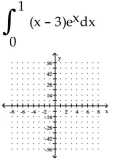
A)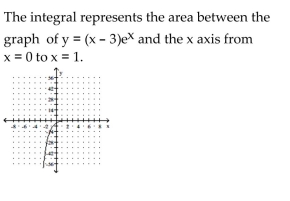
B)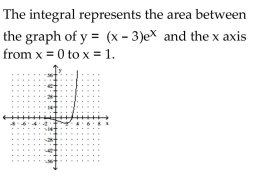
C)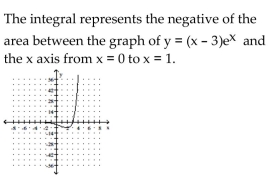
D)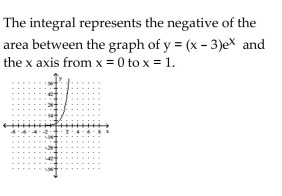

A)

B)

C)

D)


فتح الحزمة
افتح القفل للوصول البطاقات البالغ عددها 82 في هذه المجموعة.
فتح الحزمة
k this deck
52
Evaluate using integration by parts.

A) 0.94
B) 0.39
C) -1.33
D) -2.27

A) 0.94
B) 0.39
C) -1.33
D) -2.27

فتح الحزمة
افتح القفل للوصول البطاقات البالغ عددها 82 في هذه المجموعة.
فتح الحزمة
k this deck
53
Evaluate using integration by parts.

A)
B)
C)
D)

A)

B)

C)

D)


فتح الحزمة
افتح القفل للوصول البطاقات البالغ عددها 82 في هذه المجموعة.
فتح الحزمة
k this deck
54
Use a graphing calculator to graph the equation over the indicated interval and find the area between the curve and the x
axis over that interval. Find the answer to two decimal places.

A) 8.28
B) 10.42
C) 2.14
D) -6.14
axis over that interval. Find the answer to two decimal places.

A) 8.28
B) 10.42
C) 2.14
D) -6.14

فتح الحزمة
افتح القفل للوصول البطاقات البالغ عددها 82 في هذه المجموعة.
فتح الحزمة
k this deck
55
Solve the problem.
After a person takes a pill, the drug contained in the pill is assimilated into the bloodstream. The rate of assimilation minutes after taking the pill is Find the total amount of the drug that is assimilated
Find the total amount of the drug that is assimilated
Into the bloodstream during the first 15 minutes after the pill is taken. Round your answer to 2 decimal places.
A) 6.25
B) 0.23
C) 0.38
D) 6.14
After a person takes a pill, the drug contained in the pill is assimilated into the bloodstream. The rate of assimilation minutes after taking the pill is
 Find the total amount of the drug that is assimilated
Find the total amount of the drug that is assimilatedInto the bloodstream during the first 15 minutes after the pill is taken. Round your answer to 2 decimal places.
A) 6.25
B) 0.23
C) 0.38
D) 6.14

فتح الحزمة
افتح القفل للوصول البطاقات البالغ عددها 82 في هذه المجموعة.
فتح الحزمة
k this deck
56
Evaluate using integration by parts.

A)
B)
C)
D)

A)

B)

C)

D)


فتح الحزمة
افتح القفل للوصول البطاقات البالغ عددها 82 في هذه المجموعة.
فتح الحزمة
k this deck
57
Use a graphing calculator to graph the equation over the indicated interval and find the area between the curve and the x
axis over that interval. Find the answer to two decimal places.

A) 37.27
B) -35.17
C) -36.22
D) 1.05
axis over that interval. Find the answer to two decimal places.

A) 37.27
B) -35.17
C) -36.22
D) 1.05

فتح الحزمة
افتح القفل للوصول البطاقات البالغ عددها 82 في هذه المجموعة.
فتح الحزمة
k this deck
58
Evaluate using integration by parts.

A)
B)
C)
D)

A)

B)

C)

D)


فتح الحزمة
افتح القفل للوصول البطاقات البالغ عددها 82 في هذه المجموعة.
فتح الحزمة
k this deck
59
Illustrate the integral graphically and describe what the integral represents in terms of areas.
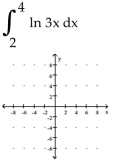
A)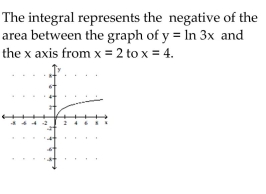
B)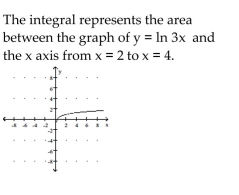
C)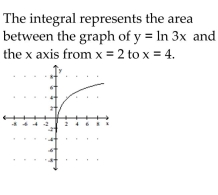
D)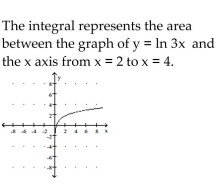

A)

B)

C)

D)


فتح الحزمة
افتح القفل للوصول البطاقات البالغ عددها 82 في هذه المجموعة.
فتح الحزمة
k this deck
60
Evaluate using integration by parts.

A)
B)
C)
D)

A)

B)

C)

D)


فتح الحزمة
افتح القفل للوصول البطاقات البالغ عددها 82 في هذه المجموعة.
فتح الحزمة
k this deck
61
Find the indefinite integral using a table of integration formulas.

A)
B)
C)
D)

A)

B)

C)

D)


فتح الحزمة
افتح القفل للوصول البطاقات البالغ عددها 82 في هذه المجموعة.
فتح الحزمة
k this deck
62
Use Simpson's rule to approximate the integral using the indicated value of n (so there are 2n subintervals).
 Write answer as whole number or reduced fraction.
Write answer as whole number or reduced fraction.
A) 18
B) 36
C) 9
D) 15
 Write answer as whole number or reduced fraction.
Write answer as whole number or reduced fraction.A) 18
B) 36
C) 9
D) 15

فتح الحزمة
افتح القفل للوصول البطاقات البالغ عددها 82 في هذه المجموعة.
فتح الحزمة
k this deck
63
Provide an appropriate response.
Use the integral table to find
A)
B)
C)
D)
Use the integral table to find

A)

B)

C)

D)


فتح الحزمة
افتح القفل للوصول البطاقات البالغ عددها 82 في هذه المجموعة.
فتح الحزمة
k this deck
64
Use Simpson's rule to approximate the integral using the indicated value of n (so there are 2n subintervals).
 Round to two decimal places.
Round to two decimal places.
A) 1.11
B) 1.03
C) 1.13
D) 1.21
 Round to two decimal places.
Round to two decimal places.A) 1.11
B) 1.03
C) 1.13
D) 1.21

فتح الحزمة
افتح القفل للوصول البطاقات البالغ عددها 82 في هذه المجموعة.
فتح الحزمة
k this deck
65
Use Simpson's rule to approximate the integral using the indicated value of n (so there are 2n subintervals).
 Round to two decimal places.
Round to two decimal places.
A) 1.20
B) 1.29
C) 1.46,
D) 1.33
 Round to two decimal places.
Round to two decimal places.A) 1.20
B) 1.29
C) 1.46,
D) 1.33

فتح الحزمة
افتح القفل للوصول البطاقات البالغ عددها 82 في هذه المجموعة.
فتح الحزمة
k this deck
66
Use the Trapezoidal Rule to approximate the integral using the indicated value of n.
 Write answer as a whole number or reduced fraction.
Write answer as a whole number or reduced fraction.
A)
B) 33
C) 16
D)
 Write answer as a whole number or reduced fraction.
Write answer as a whole number or reduced fraction.A)

B) 33
C) 16
D)


فتح الحزمة
افتح القفل للوصول البطاقات البالغ عددها 82 في هذه المجموعة.
فتح الحزمة
k this deck
67
Use Simpson's rule to approximate the integral using the indicated value of n (so there are 2n subintervals).
 Write answer as whole number or reduced fraction.
Write answer as whole number or reduced fraction.
A)
B)
C)
D)
 Write answer as whole number or reduced fraction.
Write answer as whole number or reduced fraction.A)

B)

C)

D)


فتح الحزمة
افتح القفل للوصول البطاقات البالغ عددها 82 في هذه المجموعة.
فتح الحزمة
k this deck
68
Use Simpson's rule to approximate the integral using the indicated value of n (so there are 2n subintervals).
 Round to two decimal places.
Round to two decimal places.
A) 0.30
B) 0.24
C) 0.20
D) 0.34
 Round to two decimal places.
Round to two decimal places.A) 0.30
B) 0.24
C) 0.20
D) 0.34

فتح الحزمة
افتح القفل للوصول البطاقات البالغ عددها 82 في هذه المجموعة.
فتح الحزمة
k this deck
69
Use the Trapezoidal Rule to approximate the integral using the indicated value of n.
 Round to two decimal places.
Round to two decimal places.
A) 1.62
B) 1.12
C) 1.02
D) 1.42
 Round to two decimal places.
Round to two decimal places.A) 1.62
B) 1.12
C) 1.02
D) 1.42

فتح الحزمة
افتح القفل للوصول البطاقات البالغ عددها 82 في هذه المجموعة.
فتح الحزمة
k this deck
70
Find the indefinite integral using a table of integration formulas.

A)
B)
C)
D)

A)

B)

C)

D)


فتح الحزمة
افتح القفل للوصول البطاقات البالغ عددها 82 في هذه المجموعة.
فتح الحزمة
k this deck
71
Find the indefinite integral using a table of integration formulas.

A)
B)
C)
D)

A)

B)

C)

D)


فتح الحزمة
افتح القفل للوصول البطاقات البالغ عددها 82 في هذه المجموعة.
فتح الحزمة
k this deck
72
Use Simpson's rule to approximate the integral using the indicated value of n (so there are 2n subintervals).
 Round to two decimal places.
Round to two decimal places.
A) 1.33
B) 1.24
C) 1.10
D) 0.89
 Round to two decimal places.
Round to two decimal places.A) 1.33
B) 1.24
C) 1.10
D) 0.89

فتح الحزمة
افتح القفل للوصول البطاقات البالغ عددها 82 في هذه المجموعة.
فتح الحزمة
k this deck
73
Find the indefinite integral using a table of integration formulas.

A)
B)
C)
D)

A)

B)

C)

D)


فتح الحزمة
افتح القفل للوصول البطاقات البالغ عددها 82 في هذه المجموعة.
فتح الحزمة
k this deck
74
Use the Trapezoidal Rule to approximate the integral using the indicated value of n.
 Round to three decimal places.
Round to three decimal places.
A) 9.908
B) 4.954
C) 2.477
D) 3.108
 Round to three decimal places.
Round to three decimal places.A) 9.908
B) 4.954
C) 2.477
D) 3.108

فتح الحزمة
افتح القفل للوصول البطاقات البالغ عددها 82 في هذه المجموعة.
فتح الحزمة
k this deck
75
Find the indefinite integral using a table of integration formulas.

A)
B)
C)
D)

A)

B)

C)

D)


فتح الحزمة
افتح القفل للوصول البطاقات البالغ عددها 82 في هذه المجموعة.
فتح الحزمة
k this deck
76
Use the Trapezoidal Rule to approximate the integral using the indicated value of n.
 , Write answer as a whole number or reduced fraction.
, Write answer as a whole number or reduced fraction.
A) 92
B) 46
C)
D) 23
 , Write answer as a whole number or reduced fraction.
, Write answer as a whole number or reduced fraction.A) 92
B) 46
C)

D) 23

فتح الحزمة
افتح القفل للوصول البطاقات البالغ عددها 82 في هذه المجموعة.
فتح الحزمة
k this deck
77
Find the indefinite integral using a table of integration formulas.

A)
B)
C)
D)

A)

B)

C)

D)


فتح الحزمة
افتح القفل للوصول البطاقات البالغ عددها 82 في هذه المجموعة.
فتح الحزمة
k this deck
78
Provide an appropriate response.
Use an integral table to find
A)
B)
C)
D)
Use an integral table to find

A)

B)

C)

D)


فتح الحزمة
افتح القفل للوصول البطاقات البالغ عددها 82 في هذه المجموعة.
فتح الحزمة
k this deck
79
Use Simpson's rule to approximate the integral using the indicated value of n (so there are 2n subintervals).
 , Round to three decimal places.
, Round to three decimal places.
A) 7.041
B) 7.413
C) 6.328
D) 7.741
 , Round to three decimal places.
, Round to three decimal places.A) 7.041
B) 7.413
C) 6.328
D) 7.741

فتح الحزمة
افتح القفل للوصول البطاقات البالغ عددها 82 في هذه المجموعة.
فتح الحزمة
k this deck
80
Find the indefinite integral using a table of integration formulas.

A)
B)
C)
D)

A)

B)

C)

D)


فتح الحزمة
افتح القفل للوصول البطاقات البالغ عددها 82 في هذه المجموعة.
فتح الحزمة
k this deck








